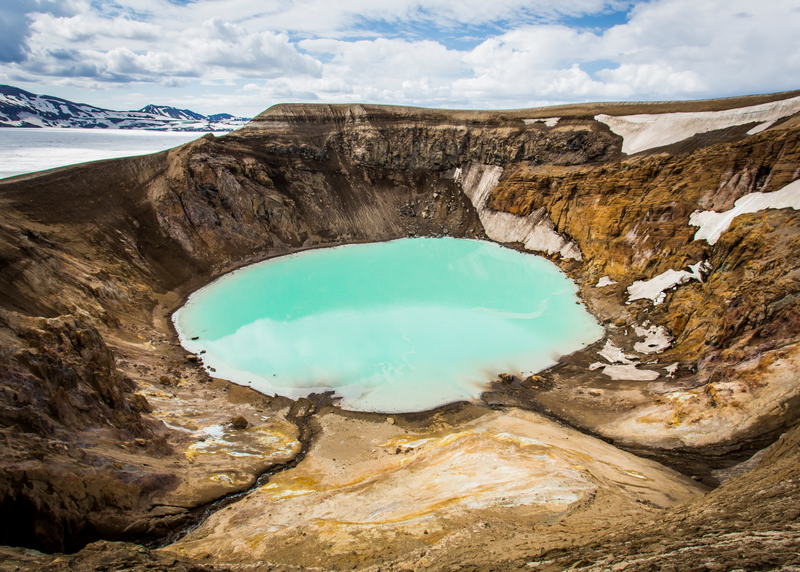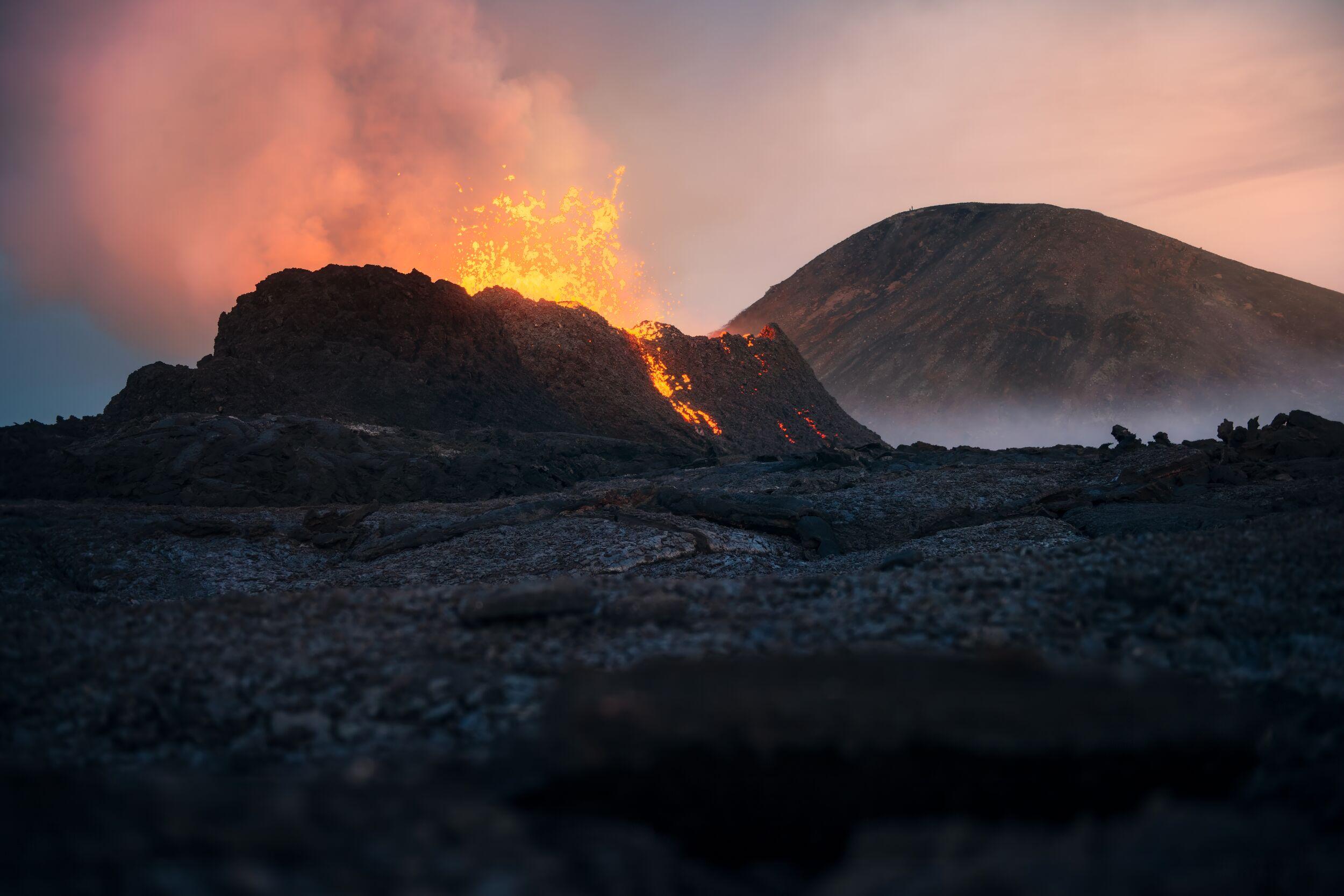
- Best time to visit
- Summer
- Coordinates
- 63.65053, -19.11458
- Distance from Reykjavík
- 160km (100mi)
How to experience Iceland’s magnificent Katla volcano
The history of the Katla volcano: Eruptions and more
You’ll often hear Katla referred to as the most dangerous volcano in Iceland.
In some ways, that’s fair. The volcano is immensely powerful, and an eruption is thought to be imminent. But Katla hasn’t proven itself to be so deadly. In fact, there are no records of fatalities resulting from its eruptions—no matter how powerful and frequent they might be.
Katla erupts every 40 to 80 years on average, although not all of these are major events. In 2011, for example, a minor eruption is thought to have occurred beneath the Mýrdalsjökull glacier. It melted some of the ice, causing a glacial flood in the Múlakvísl river, which swept away a small bridge. No one was hurt.
Major eruptions are much less frequent. There have been only 20 major eruptions recorded in the last 5,000 years, the last being in 1918. During this latest event, molten rock caused the glacier to melt. The mixture of water, dust, and ash extended the land of Iceland by about five kilometres out to sea. Again, no one was hurt.
Now, in recent years, another eruption has been expected. In 2016 and 2017, small earthquakes were recorded at the volcano, in a sign that something was going on. What’s more, scientists have noted that every time Eyjafjallajökull erupts, Katla doesn’t wait too long to erupt either. Eyjafjallajökull erupted in 2010—you may remember it—suggesting more activity is on its way.
That said, Katla is perfectly safe to visit. It’s monitored at all times for tremors and minor eruptions, so if something big is about to happen, we’ll know about it before it does. The only thing to be aware of is that that’s expected fairly soon.
How to visit the Katla volcano
As we said, the Katla volcano and its surroundings are perfectly safe to visit. It’s something you shouldn’t miss on a trip to Iceland.
Katla is situated at the heart of Iceland’s south coast, partially covered by the glacier known as Mýrdalsjökull. You can see this glacier from Route 1, Iceland’s Ring Road, or from the small fishing village of Vík. In fact, it’s visible from most of the drive along the south coast.
There are many ways to get closer to this famed volcano. Whether you want to see Katla on a hike, a snowmobile, or on an ice cave adventure, there’s something here for everyone.
One of the most popular ways to visit Katla is on a glacier hike. Starting from the Sólheimajökull base camp—next to the Sólheimajökull glacier, an offshoot of Mýrdalsjökull, you can hike up to a series of panoramic points. You’ll see Eyjafjallajökull and, of course, the mighty Katla.
Alternatively, explore Mýrdalsjökull on a snowmobile. Mýrdalsjökull is the glacier that covers part of the Katla volcano—and it typically cracks and partially melts when the volcano erupts. The rest of the time, as Iceland’s fourth largest glacier, it’s a gorgeous icy expanse stretching far into the distance.
You’ll ride across the ice and explore the breathtaking forms of this active volcanic landscape. You won’t get views like this anywhere else.
If you’re feeling adventurous, why not explore beneath the ice too? The Katla volcano ice cave is a natural cave in the Kötlujökull glacier, another offshoot of Mýrdalsjökull. It’s known for being one of the few caves in Iceland that can be visited all year round. Visit to get a different perspective on this mighty volcano.
Other things to see around Katla
The Katla volcano is at the heart of southern Iceland. It’s also the centrepiece of the Katla UNESCO Global Geopark, an area of global importance thanks to its very special geographic assets.
That means there’s plenty to see in the area, from other volcanoes to glaciers, and even beaches made of black sand.
For instance, the Geopark is home to one of the most geothermally active areas in Iceland. You’ll find the notorious volcanoes, Eyjafjallajökull, Grímsvötn, Lakagígar, and Eldgjá, in the region, alongside Katla itself. Volcanic landforms such as black-sand plains and lava flows are difficult to find anywhere else. It’s well worth exploring this area on an all-terrain vehicle tour.
Alternatively, visit the area between Eyjafjallajökull and Mýrdalsjökull to see the impact that volcanoes can have. Take the Fimmvörðuháls hiking route, for example, between Þórsmörk and Skógar, to see the craters formed in the 2010 eruption.
While you’re in the area, make sure you stop to see the immense waterfalls that are dotted along this part of the coast. Skógafoss and Seljalandsfoss are two of the most impressive.
Finally, don’t miss Vík, the village that lives in the shadow of Katla. With its lively atmosphere and the nearby Reynisfjara—the famous black-sand beach—it’s a must-visit on the south coast.
All about Katla Volcano
You should never enter an ice cave without a guide. Ice caves are delicate and volatile spaces that are very sensitive to changes in temperature and weather conditions. They’re simply not safe if you are not familiar with the local environment.
That’s what tour guides are for. Equipped with local knowledge of the changing conditions, they’ll ensure the caves are safe to enter.
Katla is known as one of the most dangerous volcanoes in Iceland. In fact, scientists are continually warning that an eruption is due soon—and that it could be deadly.
But it’s not just Katla that poses a threat to Icelanders and potentially to the wider world. The Katla volcano system also includes Laki, the volcano which erupted in 1784 to catastrophic effect across Europe.
Together, they’re a pretty deadly team. And only time will tell when they’ll next erupt.
The name Katla in Icelandic translates to “kettle” or “cauldron”. It’s not hard to guess why!
The Katla UNESCO Global Geopark is home to the volcano that gives it its name. The Geopark stretches from Hvolsvöllur to the west of the volcano to Skeiðarárjökull, a glacier that makes up part of the Vatnajökull ice cap, Europe’s largest.
The reason Katla and the surrounding area have been named as a UNESCO site is its volcanic activity. Aside from Katla, one of Iceland’s most potentially dangerous volcanoes, Eyjafjallajökull, Grímsvötn, Lakagígar, and Eldgjá are also included in this park.
The Katla ice cave is one of the very few ice caves in Iceland that is open to the public all year round. Like other caves, Katla’s will change shape throughout the season, but the cave itself remains.
That said, the ice cave is best seen in winter. This is the season when you’ll be most in the mood to visit this frozen sight!
Katla is very much a real volcano. In fact, it’s one of Iceland’s biggest. You’ll find it along the south coast of Iceland, half covered by the glacier known as Mýrdalsjökull.
While it hasn’t erupted since 1918, it’s still classed as an active volcano. There have been about 20 major eruptions in the last 5,000 years—as well as lots of smaller ones—and another eruption is thought to be not far away.
Recent eruptions of Katla have typically been preceded by an eruption of Eyjafjallajökull, the volcano next door. If you remember, that volcano erupted in 2010.
There is a story of how Katla got its name.
Back in the 12th century, there was a monastery at Þykkvabæjarklaustur, not far from the volcano. In the abbey, there was a housekeeper, Katla, who was rumoured to be a witch due to her horrible temper. Alongside her temper, she was known for having a pair of magic trousers, which allowed whoever wore them to run incredibly fast without getting tired.
One day, Katla and the abbot of the monastery were out on a visit. Katla had told a young shepherd boy, Barði, to make sure that all the sheep were rounded up by the time they returned. But he couldn’t find them, so stole Katla’s trousers to track them down as quickly as possible.
Discovering that Barði had stolen her trousers, Katla drowned him in a vat of whey. But soon she feared being found out. And so she put on her magic trousers and ran up to the Mýrdalsjökull and threw herself into a canyon. Immediately, the volcano erupted, flooding the south coast with water.
The volcano has been known by Katla’s name ever since.
Past eruptions of Katla have been fairly major events. While it’s not certain that another eruption would be so large, Icelandic authorities have been preparing for a long time.
For example, back in 1918, the year of Katla’s last major eruption, the landscape of southern Iceland was changed dramatically. Sand and ash from the volcano mixed with water from the melting glacier to extend the south coast by as much as five kilometres. Luckily, no one was hurt.
Then, in 2011, after Eyjafjallajökull erupted, Katla awoke momentarily to spit out magma beneath the Mýrdalsjökull glacier. This caused a glacial flood that swept away a bridge. It’s this flooding that is the biggest risk of Katla’s eruptions. As the volcano sits beneath a glacier, it’s very likely that it will cause the ice to melt—and the threat of flash flooding is very real. Luckily, though, the Icelandic authorities are prepared for it.
No one quite knows how large the eruption will be if Katla erupts again soon. Like the Eyjafjallajökull of 2010, it’s likely that it will disrupt air traffic—at the very least.
Katla is not a supervolcano. Supervolcanoes are volcanoes whose eruptions are expected to have catastrophic effects on the global climate. Katla is not expected to do this.
Scientists measure the effects of volcanic eruptions using the Volcano Explosivity Index (VEI). To be classified as a supervolcano, eruptions need to be at level 8 on the scale. However, Katla has only reached VEI 4 and 5 in the past.
Taupo in New Zealand, which erupted over 22,000 years ago, is the last supervolcano to have erupted.
The Katla ice cave is a natural and ancient ice cave beneath the Kötlujökull glacier, an offshoot of the larger Mýrdalsjökull. It’s an incredible opportunity to see the otherworldly patterns of ice beneath the surface.
When Katla has erupted in the past, this activity has been preceded by an eruption of Eyjafjallajökull. Of course, Eyjafjallajökull erupted in 2010—and that’s one of the main reasons why many scientists think that Katla is due to erupt quite soon.
However, volcanoes don’t always follow the script, so we’ll have to wait and see. What we do know though is that Katla is an active volcano, so could potentially erupt at any moment.
The Katla volcano is at the heart of the south coast of Iceland. It’s not far from many villages and settlements.
For example, the fishing village—and popular visitor destination—Vík í Mýrdal is very close to the volcano. It has a population of about 750.
Katla typically has a small eruption every 40 to 80 years. For example, the last one was in 2011, when magma beneath the Mýrdalsjökull glacier caused the ice to melt and flood the local area.
However, they’re not often major eruptions. Larger eruptions have happened 20 times in the last 5,000 years. We’re expecting another one soon.
While Katla itself is buried beneath the Mýrdalsjökull glacier, you can easily visit the surrounding area. One of the best ways to do that is to tour the glacier.
For example, you can take a snowmobile to see the extraordinary views and landscapes that surround the volcano. Or explore on foot, to visit the breathtaking area at your own pace.



